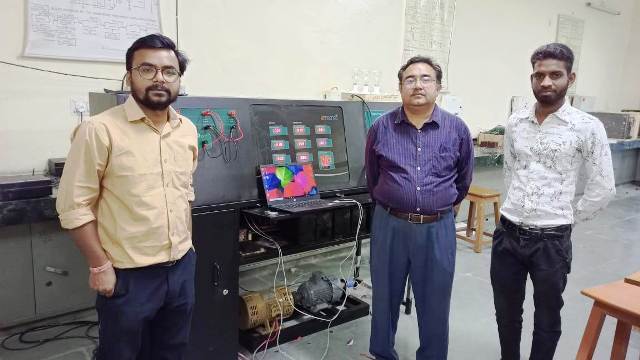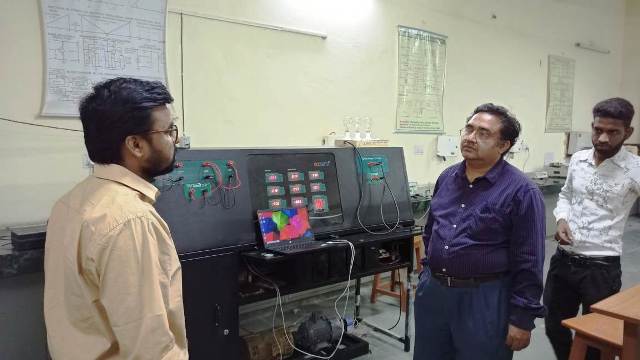Ecosense installs Wind-PV Hybrid systems at CTAE, Udaipur
Ecosense installed Wind- PV Hybrid systems at Department of Electrical Engineering, College of Technology and Engineering, Udaipur

Ecosense installed Wind- PV Hybrid systems at Department of Electrical Engineering, College of Technology and Engineering, Udaipur
Ecosense installs
Wind- PV Hybrid systems at Department of Electrical Engineering, College of
Technology and Engineering, Udaipur.
Wind- PV Hybrid
systems utilise 2 energy sources, Wind Energy and Solar energy for renewable
electricity production. The renewable energy systems are weather dependent
which makes their instantaneous production output uncertain, to compensate the
lower production of output due to change in weather using multiple energy
sources is a good idea. Renewable Energy systems with multiple energy sources
and single output is known as hybrid systems.
At Department of
Electrical Engineering in College of Technology and Engineering, Udaipur,
Ecosense has installed 2 types of system:
This system
utilises two energy sources an actual 400-Watt Wind Turbine and actual 500 W
Solar PV array as the energy sources. The output of both the energy sources are
fed to a charge controller which is further connected to a battery bank and
Inverter to complete a standalone hybrid system. The DC loads can be connected
at battery output and AC loads can be connected to Inverter output. The system
represents a mini hybrid standalone powerplant. As the system is made for
laboratory usage, for ease of experimentation the system is fitted with an
artificial wind generator which provides wind energy to the wind turbine for
power generation.
Using this
system, a user can learn about the Wind and Solar technology and can experiment
on the following parameters:
·
Evaluate efficiency of
charge controller
·
Evaluate start-up speed and
cut-in speed of wind turbine
·
Evaluate the Tip speed ratio
at different wind speeds
·
Evaluate coefficient of
performance of wind turbine
·
Draw Turbine vs wind power
curve
·
Draw the curve between TSR
and coefficient of power
·
Draw the power curve of
turbine with respect to the rotational speed of rotor at fix wind speeds
·
Demonstrate the power
analysis at different branches of the system with only AC loads
·
Demonstrate the power
analysis at different branches of the system with only DC loads
On the other
hand, a Wind Turbine Emulator- Solar PV Hybrid system utilises a Wind Turbine
Emulator instead of actual Wind Turbine
Why Emulator?
Wind turbine emulator mimics the behaviour of actual
wind turbine under controlled manner. Essentially it simulates the same
operating pattern at hardware level in real time similar to what an actual wind
turbine does at given operating parameters of wind speed and pitch angle.
Term Emulation is coined for simulation practices
which involve hardware platform. In simple words, emulation is hardware level
simulation. It provides a fast configurable testing platform. Usually these are
performed in real time. Emulator is similar to Hardware-In-Loop simulation
concepts. Wind turbine emulator can find applications in numerous fields. It
provides a flexible testing platform for study of dynamic and steady state
behaviour of wind turbine. Beginners can learn about Power/wind speed, Torque/turbine
speed and Power/turbine speed characteristics of a wind turbine and can-do
comparative studies about how changes in parameters of wind turbine affect the
behaviour.
For other applications, this emulator can be coupled
to the generator (Induction, PMSG, DFIG) followed by power electronics in place
of actual wind turbine. So, researchers would not have to rely on environmental
conditions which are appropriate for driving the wind turbine at some desired
operating point. Since the operating point of wind emulator can be controlled,
researcher can simulate all possible scenarios of operation of wind turbine and
accordingly can modify the power electronics & control algorithms.
Consequently, it will improve the product quality and reliability.
Using this
system, a user can learn about the Wind and Solar technology and can carry on
research on the following topics:
·
DC-side Load management
·
User controlled, cost
effective way to test response of PV system for wide range of solar panels
·
Simulate the I-V curve
under varying environmental conditions
·
Test and verify different
parameters of PV system like – MPPT tracking algorithm of PV inverter,
efficiency of MPPT tracking
·
Measure and verify the
overall efficiency and conversion efficiency of PV inverter for variety of
solar panels and in varying weather conditions
·
Real time Emulation of
Static and dynamic behavior of Wind Turbine
·
Power balancing using
battery bank and bidirectional converter
·
3 phase inverters control for standalone
and grid tied system in Wind Emulator
·
Exhibits both static and
dynamic behaviour close to real wind turbine.
·
Intuitive graphical user
interface & data acquisition for control and monitoring of various
parameters.
·
Capability to change wind
turbine parameters (within permissible range).
·
FPGA board for solving
the differential equations in real time, additionally on-board ADC channels and
PWM port for power electronics converter/inverter firing.
·
Suitable for
Hardware-in-Loop simulations.

The faculty members and students really enjoyed our two-day training
programme and loved to work on our lab equipment. Professors will conduct
experiments on the system to understand it more deeply and incorporate this lab
set up as part of their regular curriculum.